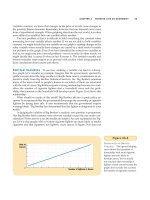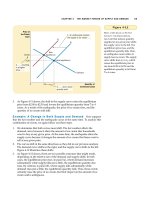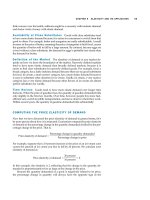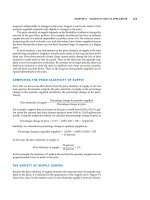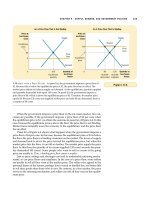Tài liệu Ten Principles of Economics - Part 18 ppt
Bạn đang xem bản rút gọn của tài liệu. Xem và tải ngay bản đầy đủ của tài liệu tại đây (231.55 KB, 10 trang )
CHAPTER 8 APPLICATION: THE COSTS OF TAXATION 177
7. Senator Daniel Patrick Moynihan once introduced a bill
that would levy a 10,000 percent tax on certain hollow-
tipped bullets.
a. Do you expect that this tax would raise much
revenue? Why or why not?
b. Even if the tax would raise no revenue, what
might be Senator Moynihan’s reason for
proposing it?
8. The government places a tax on the purchase of socks.
a. Illustrate the effect of this tax on equilibrium price
and quantity in the sock market. Identify the
following areas both before and after the imposition
of the tax: total spending by consumers, total
revenue for producers, and government tax
revenue.
b. Does the price received by producers rise or fall?
Can you tell whether total receipts for producers
rise or fall? Explain.
c. Does the price paid by consumers rise or fall? Can
you tell whether total spending by consumers rises
or falls? Explain carefully. (Hint: Think about
elasticity.) If total consumer spending falls, does
consumer surplus rise? Explain.
9. Suppose the government currently raises $100 million
through a $0.01 tax on widgets, and another $100
million through a $0.10 tax on gadgets. If the
government doubled the tax rate on widgets and
eliminated the tax on gadgets, would it raise more
money than today, less money, or the same amount of
money? Explain.
10. Most states tax the purchase of new cars. Suppose that
New Jersey currently requires car dealers to pay the
state $100 for each car sold, and plans to increase the tax
to $150 per car next year.
a. Illustrate the effect of this tax increase on the
quantity of cars sold in New Jersey, the price paid
by consumers, and the price received by producers.
b. Create a table that shows the levels of consumer
surplus, producer surplus, government revenue,
and total surplus both before and after the tax
increase.
c. What is the change in government revenue? Is it
positive or negative?
d. What is the change in deadweight loss? Is it
positive or negative?
e. Give one reason why the demand for cars in New
Jersey might be fairly elastic. Does this make the
additional tax more or less likely to increase
government revenue? How might states try to
reduce the elasticity of demand?
11. Several years ago the British government imposed a
“poll tax” that required each person to pay a flat
amount to the government independent of his or her
income or wealth. What is the effect of such a tax on
economic efficiency? What is the effect on economic
equity? Do you think this was a popular tax?
12. This chapter analyzed the welfare effects of a tax on a
good. Consider now the opposite policy. Suppose that
the government subsidizes a good: For each unit of the
good sold, the government pays $2 to the buyer. How
does the subsidy affect consumer surplus, producer
surplus, tax revenue, and total surplus? Does a subsidy
lead to a deadweight loss? Explain.
13. (This problem uses some high school algebra and is
challenging.) Suppose that a market is described by the
following supply and demand equations:
Q
S
= 2P
Q
D
= 300 Ϫ P
a. Solve for the equilibrium price and the equilibrium
quantity.
b. Suppose that a tax of T is placed on buyers, so the
new demand equation is
Q
D
= 300 Ϫ (P ϩ T).
Solve for the new equilibrium. What happens to the
price received by sellers, the price paid by buyers,
and the quantity sold?
c. Tax revenue is T ϫ Q. Use your answer to part (b)
to solve for tax revenue as a function of T. Graph
this relationship for T between 0 and 300.
d. The deadweight loss of a tax is the area of the
triangle between the supply and demand curves.
Recalling that the area of a triangle is 1/2 ϫ base ϫ
height, solve for deadweight loss as a function of T.
Graph this relationship for T between 0 and 300.
(Hint: Looking sideways, the base of the
deadweight loss triangle is T, and the height is the
difference between the quantity sold with the tax
and the quantity sold without the tax.)
e. The government now levies a tax on this good of
$200 per unit. Is this a good policy? Why or why
not? Can you propose a better policy?
IN THIS CHAPTER
YOU WILL . . .
Examine the
arguments people
use to advocate
trade restrictions
Learn that the gains
to winners from
international trade
exceed the losses
to losers
Consider what
determines whether
a country imports
or exports a good
Examine who wins
and who loses from
international trade
Analyze the welfare
effects of tariffs
and import quotas
If you check the labels on the clothes you are now wearing, you will probably find
that some of your clothes were made in another country. A century ago the textiles
and clothing industry was a major part of the U.S. economy, but that is no longer
the case. Faced with foreign competitors that could produce quality goods at low
cost, many U.S. firms found it increasingly difficult to produce and sell textiles and
clothing at a profit. As a result, they laid off their workers and shut down their fac-
tories. Today, much of the textiles and clothing that Americans consume are im-
ported from abroad.
The story of the textiles industry raises important questions for economic pol-
icy: How does international trade affect economic well-being? Who gains and who
loses from free trade among countries, and how do the gains compare to the
losses?
APPLICATION:
INTERNATIONAL TRADE
179
180 PART THREE SUPPLY AND DEMAND II: MARKETS AND WELFARE
Chapter 3 introduced the study of international trade by applying the princi-
ple of comparative advantage. According to this principle, all countries can bene-
fit from trading with one another because trade allows each country to specialize
in doing what it does best. But the analysis in Chapter 3 was incomplete. It did not
explain how the international marketplace achieves these gains from trade or how
the gains are distributed among various economic actors.
We now return to the study of international trade and take up these questions.
Over the past several chapters, we have developed many tools for analyzing how
markets work: supply, demand, equilibrium, consumer surplus, producer surplus,
and so on. With these tools we can learn more about the effects of international
trade on economic well-being.
THE DETERMINANTS OF TRADE
Consider the market for steel. The steel market is well suited to examining the
gains and losses from international trade: Steel is made in many countries around
the world, and there is much world trade in steel. Moreover, the steel market is one
in which policymakers often consider (and sometimes implement) trade restric-
tions in order to protect domestic steel producers from foreign competitors. We ex-
amine here the steel market in the imaginary country of Isoland.
THE EQUILIBRIUM WITHOUT TRADE
As our story begins, the Isolandian steel market is isolated from the rest of the
world. By government decree, no one in Isoland is allowed to import or export
steel, and the penalty for violating the decree is so large that no one dares try.
Because there is no international trade, the market for steel in Isoland consists
solely of Isolandian buyers and sellers. As Figure 9-1 shows, the domestic price ad-
justs to balance the quantity supplied by domestic sellers and the quantity de-
manded by domestic buyers. The figure shows the consumer and producer
surplus in the equilibrium without trade. The sum of consumer and producer
surplus measures the total benefits that buyers and sellers receive from the steel
market.
Now suppose that, in an election upset, Isoland elects a new president. The
president campaigned on a platform of “change” and promised the voters bold
new ideas. Her first act is to assemble a team of economists to evaluate Isolandian
trade policy. She asks them to report back on three questions:
◆ If the government allowed Isolandians to import and export steel, what
would happen to the price of steel and the quantity of steel sold in the
domestic steel market?
◆ Who would gain from free trade in steel and who would lose, and would the
gains exceed the losses?
◆ Should a tariff (a tax on steel imports) or an import quota (a limit on steel
imports) be part of the new trade policy?
CHAPTER 9 APPLICATION: INTERNATIONAL TRADE 181
After reviewing supply and demand in their favorite textbook (this one, of course),
the Isolandian economics team begins its analysis.
THE WORLD PRICE AND COMPARATIVE ADVANTAGE
The first issue our economists take up is whether Isoland is likely to become a steel
importer or a steel exporter. In other words, if free trade were allowed, would
Isolandians end up buying or selling steel in world markets?
To answer this question, the economists compare the current Isolandian price
of steel to the price of steel in other countries. We call the price prevailing in world
markets the world price. If the world price of steel is higher than the domestic
price, then Isoland would become an exporter of steel once trade is permitted.
Isolandian steel producers would be eager to receive the higher prices available
abroad and would start selling their steel to buyers in other countries. Conversely,
if the world price of steel is lower than the domestic price, then Isoland would be-
come an importer of steel. Because foreign sellers offer a better price, Isolandian
steel consumers would quickly start buying steel from other countries.
In essence, comparing the world price and the domestic price before trade in-
dicates whether Isoland has a comparative advantage in producing steel. The do-
mestic price reflects the opportunity cost of steel: It tells us how much an
Isolandian must give up to get one unit of steel. If the domestic price is low, the
cost of producing steel in Isoland is low, suggesting that Isoland has a comparative
advantage in producing steel relative to the rest of the world. If the domestic price
is high, then the cost of producing steel in Isoland is high, suggesting that foreign
countries have a comparative advantage in producing steel.
Price
of Steel
Equilibrium
price
0
Quantity
of Steel
Equilibrium
quantity
Domestic
supply
Domestic
demand
Producer
surplus
Consumer
surplus
Figure 9-1
T
HE
E
QUILIBRIUM WITHOUT
I
NTERNATIONAL
T
RADE
. When
an economy cannot trade in
world markets, the price adjusts
to balance domestic supply and
demand. This figure shows
consumer and producer surplus
in an equilibrium without
international trade for the steel
market in the imaginary country
of Isoland.
world price
the price of a good that prevails in
the world market for that good
